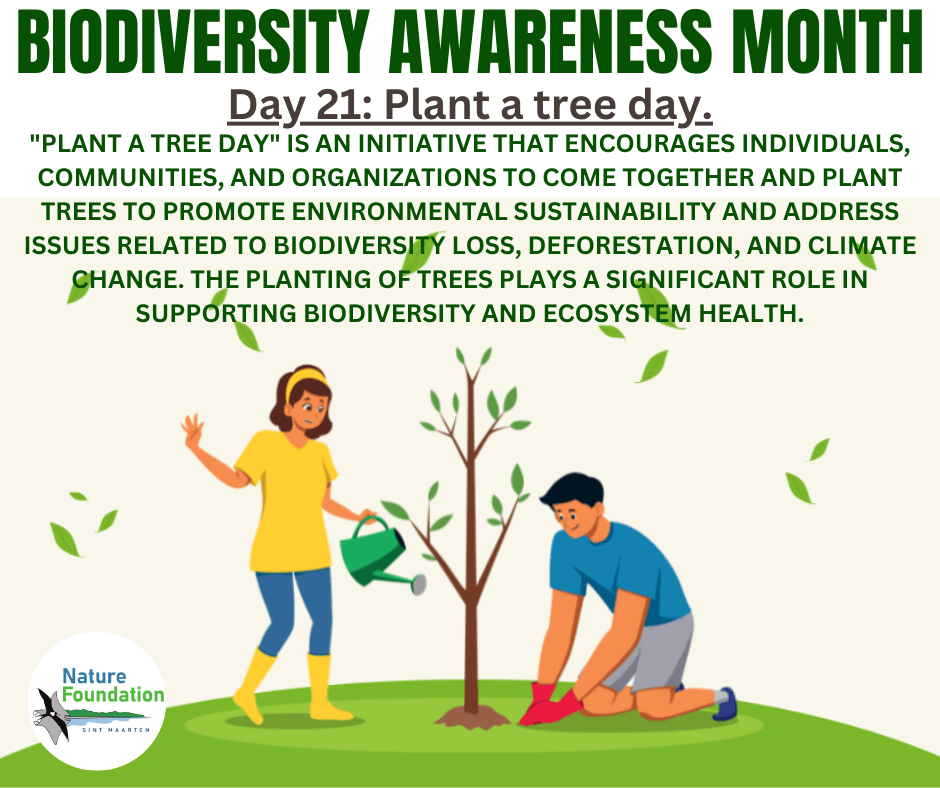Biodiversity month day 21: Plant a tree day
The St. Maarten Hospitality & Trade Association supports the March Biodiversity awareness month organized by the Nature Foundation in an effort to help protect St. Maartens nature and biodiversity. Todays topic: Plant a tree day
“Plant a Tree Day” is an initiative that encourages individuals, communities, and organizations to come together and plant trees to promote environmental sustainability and address issues related to biodiversity loss, deforestation, and climate change. The planting of trees plays a significant role in supporting biodiversity and ecosystem health. Here are ways in which “Plant a Tree Day” contributes to biodiversity conservation:
1. Habitat Restoration: Tree planting contributes to habitat restoration by reintroducing native tree species to areas affected by deforestation or urbanization. This helps recreate suitable habitats for various plant and animal species, contributing to increased biodiversity.
2. Biodiversity Support: Trees provide habitats for a wide range of organisms, including birds, insects, fungi, and microorganisms. By planting diverse tree species, “Plant a Tree Day” initiatives help support a variety of life forms and contribute to overall ecosystem biodiversity.
3. Connectivity of Ecosystems: Trees play a crucial role in connecting ecosystems. They can serve as corridors or steppingstones for wildlife, allowing species to move between fragmented habitats. This connectivity helps maintain genetic diversity and supports healthy populations.
4. Soil Health Improvement: Trees contribute to soil health by preventing erosion, enhancing soil structure, and promoting nutrient cycling. Healthy soils support a diverse array of plant life, which in turn provides food and habitat for various animals.
5. Carbon Sequestration and Climate Regulation: Trees absorb carbon dioxide during photosynthesis, helping mitigate climate change. By participating in “Plant a Tree Day,” individuals contribute to carbon sequestration, aiding in the regulation of global climate patterns.
6. Water Quality Improvement: Trees play a role in improving water quality by preventing soil erosion and acting as natural filters. The roots of trees help absorb pollutants and reduce runoff, contributing to healthier aquatic ecosystems and supporting aquatic biodiversity.
7. Educational Opportunities: “Plant a Tree Day” provides educational opportunities to raise awareness about the importance of trees and biodiversity. Workshops, seminars, and educational programs can accompany tree-planting events, fostering a deeper understanding of ecosystems.
8. Community Engagement: Tree-planting activities bring communities together to work towards a common environmental goal. This engagement builds a sense of environmental stewardship and community responsibility, contributing to long-term biodiversity conservation efforts.
9. Urban Biodiversity Enhancement: Tree planting in urban areas helps enhance local biodiversity by providing green spaces and habitats for urban wildlife. This is crucial for maintaining ecological balance in urban ecosystems.
10. Long-Term Impact: While “Plant a Tree Day” is a specific event, the long-term impact of trees planted on this day contributes to biodiversity conservation for years to come. As trees grow, they continue to provide ecosystem services and support diverse life forms.
11. Wildlife Shelter and Food Source: Trees offer shelter and act as a source of food for many wildlife species. The fruits, nuts, and foliage of trees attract a variety of animals, supporting their nutritional needs and enhancing local biodiversity.
In summary, “Plant a Tree Day” contributes significantly to biodiversity conservation by restoring habitats, supporting diverse ecosystems, and engaging communities in sustainable environmental practices. It is a tangible and positive action that individuals and groups can take to address global environmental challenges.
Back to the Visit St Maarten Main page

